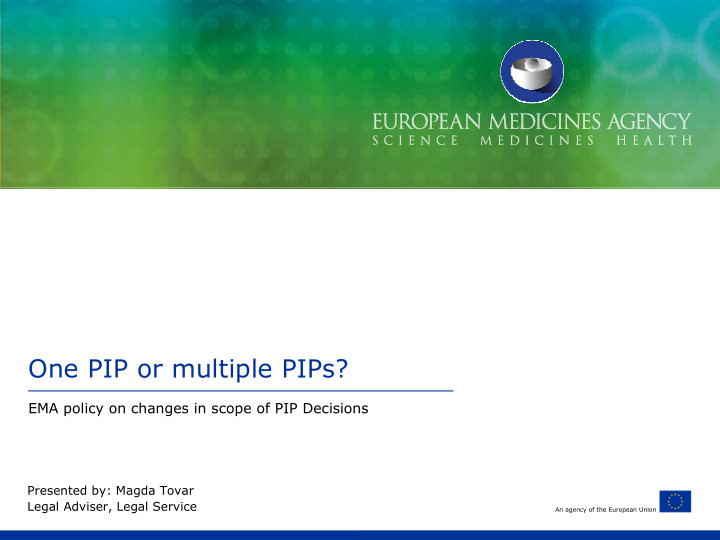



One PIP or multiple PIPs? EMA policy on changes in scope of PIP Decisions Presented by: Magda Tovar Legal Adviser, Legal Service An agency of the European Union
Background • During product development companies may change strategy and timing of MA submissions • An agreed PIP may not correspond to the content of the MA submission (lack of congruence). E.g.: – applicants may decide to apply simultaneously for several conditions when only one was originally planned – applicants may decide to apply for a single condition when several were originally planned – applicants may decide to group conditions differently from what was originally envisaged 1
Aim • Present the EMA policy on the handling of PIP decisions that do not match the scope of the intended regulatory submission. • The policy takes into account Regulation (EC) No 1901/2006 requirements (‘the Paediatric Regulation’): – Arts 7 and 8: MA requirements, scope of PIP applications – Art 23: Compliance check – Art 28(3) and Arts 36-38: Reward requirements Inclusion of results & compliance statement in SmPC Full completion of PIP MA in all Member States 2
• The policy also follows the Commission Communication 2008/C 243/01 (section 2.1): “Applications for products falling within the scope of Article 8 of the paediatric regulation should cover the existing and the new indications, pharmaceutical forms and routes of administration. In this case one comprehensive paediatric investigation plan should be included in the application. Similarly, when it is intended to develop several indications simultaneously, only one comprehensive paediatric investigation plan should be included in the application.” 3 3
Principles (1): • One single PIP Decision for conditions developed simultaneously (i.e. covered by a single regulatory submission – or by several regulatory submissions submitted at the same time) • Both for applications under Art 7 or 8 • For Art 8 applications, the PIP must cover existing and new i./p.f./r.o.a • The PIP Decision does not need to cover conditions that will be developed later, in a subsequent regulatory submission. These conditions may be addressed in a separate PIP. 4
Principles (2): • Need to modify PIP Decisions in order to align them to scope of regulatory submission: • Scope of PIP Decisions may need to be broadened to include all the conditions covered by the regulatory submission(s) (‘merging’ of PIP Decisions). • Scope of PIP Decisions may need to be reduced if regulatory submission(s) does not cover all conditions foreseen in the original PIP (voluntary – faster access to reward. See below) 5
Principles (3): • The EMA Decision corresponding to the first regulatory submission attracting a PIP (as opposed to a waiver) is the one susceptible to be rewarded: “PIP eligible for the reward” • PIP eligible for reward must be fully completed in order to obtain reward (+ Arts 28 and 36-38 of Paediatric Regulation) • PIP eligible for reward does not need to be modified if application for new i., p.f. or r.o.a. is made at a later stage. • Measures related to new application can be subject to a separate PIP without delaying completion of PIP eligible for the reward 6
Principles (4): • When a subsequent regulatory submission is made, applicants may submit a separate PIP Decision covering the existing and new indications, pharmaceutical forms and routes of administration (Art 8). • The PIP for the subsequent regulatory submission may cross- refer to the existing PIP: • No need to reproduce content of existing PIP • Avoid modification of new PIP if existing PIP is modified 7 7
Procedure • Altering scope of PIP decision in order to align to content of regulatory submission will be done via modification procedure: • Art 22 of Paediatric Regulation • PDCO will appoint new rapporteur and peer-reviewer • New summary report and PDCO opinion • New EMA Decision Timelines may be shortened if modification is limited to a change of scope of the PIP The PIP Decision for subsequent regulatory submissions may cross-refer to previous EMA Decision(s) 8 8
Practical examples (1) Article 7 PIP1 Condition A PIP2 Condition B Applicant plans simultaneous regulatory submissions for A and B One comprehensive PIP Decision covering A+B needed at the time of regulatory submission (application for modification to ‘merge’ PIP1 and PIP2) Consolidated PIP covering A+B = PIP eligible for reward 9 9
Practical examples (2) Article 7 PIP1 Conditions A + B Applicant plans regulatory submission for A only Applicant may apply for modification to reduce scope of PIP1 to Condition A (voluntary) PIP covering A = PIP eligible for reward Options with regard to B: Separate PIP application may be submitted in view of subsequent regulatory application (Art 8: PIP shall cover A+B) If development of B is discontinued no new PIP Decision needed 10 10
Practical examples (3) Article 7 PIP 1 Conditions A + B Applicant plans simultaneous regulatory submissions for A and C One comprehensive PIP Decision covering A+C needed at the time of regulatory submission Application for modification to add condition C to PIP1 is required Condition B may be removed from PIP1 (voluntary) Consolidated PIP covering A+C = PIP eligible for reward 11 11
Practical examples (4) Article 8 PIP1 Condition A (deferral in children) 1 st Regulatory submission for A (adults) 2 nd Regulatory submission for B. Must provide PIP2 (A+B) 3 rd Regulatory submission for A in children. Must provide PIP1(A) and PIP2 (A+B) (Art 8) PIP1 = PIP eligible for reward 12 12
Conclusions • When development is simultaneous, one consolidated PIP covering the scope of the regulatory submission(s) is required. • EMA will not accept separate PIP Decisions for simultaneous regulatory submission(s): • Difficulty to identify a PIP eligible for reward • Administrative tracking would be extremely complicated for EMA and national competent authorities. 13 13
Conclusions • Policy’s disadvantages: Modifications: administrative burden (cross-references available, possible shortened time-lines) • Policy’s advantages: Facilitates administrative tracking Facilitates access to reward 14 14
Thank you for your attention! Any questions ? magda.tovar@ema.europa.eu 15 15
Recommend
More recommend